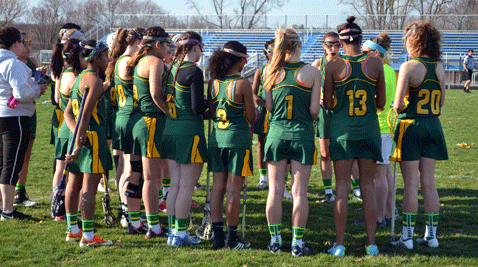
By Stephanie Gutierrez-Munguia
Capital News Service
US Lacrosse is expected to make a decision by early 2015 on a standard for optional soft headgear for women’s lacrosse, said Paul Ohanian, a marketing and public relations manager.
Girl lacrosse players are currently required to wear protective eye goggles and mouth guards, and may wear optional soft headgear, but there are no standards for that, said Melissa Coyne, director of the women’s game for US Lacrosse.
Members of ASTM International, which is working with US Lacrosse to help set a headgear standard, will wrap up votes on a proposed standard in the new year, both said.
“What we’ve had to do was look at what were the impact forces. If I smack you on the head with a lacrosse stick, what kind of force does that generate on girls?” Coyne said.
US Lacrosse and ASTM’s work was aided by Dr. Joseph Crisco from Brown University, who conducted an independent study on a range of impact forces. Seven female lacrosse players, ages 12 to 14, participated. Each girl smacked a head form as hard as she could, Coyne said, to see what kind of helmet is needed to protect against the impacts.
“Once they determined those impact forces, our goal, with the standard, was how much can we mitigate those forces? Is it 50 percent?” Coyne said. “That’s what that standard will do. It’s a performance standard.”
The only player who is required to wear a helmet in women’s and girl’s lacrosse is the goalkeeper. The goalkeeper wears a protective hard helmet equipped with a face mask, which is approved by the National Operating Committee on Standards for Athletic Equipment. The goalkeeper also wears a separate throat protector, padded gloves, mouth piece and chest protector, according to the US Lacrosse website.
The girls’ and women’s standard for protective headgear differs from the boys’ and men’s standard. Boys must wear hard, full-head helmets and various body pads.
Coyne has said the males wear more protective gear because they are allowed to body check. Checking, in general, is not allowed in girls’ lacrosse, she said, due to a difference in rules.
According to US Lacrosse, body checking is when “a player intentionally contacts another player with his body to prevent advancement to the goal or gain possession of a loose ball.”
National studies underscore that concussions are a risk in both girls’ and boys’ lacrosse.
A 2012 study by The American Journal of Sports Medicine looked at high school athletes from 2008 to 2010 and found that girls’ lacrosse had the fourth highest concussion rate out of 20 studied — behind boys’ football, boys’ ice hockey and boys’ lacrosse.
In other action, US Lacrosse approved a rulebook change in October intended to improve safety on the women’s lacrosse field.
“Ideally, I would have liked it to happen yesterday, but I’m very excited it’s going to happen at all,” Coyne said.
Rule 3, Section 10 in the rulebook says that beginning Jan. 1, 2017, games must be officiated by at least two US Lacrosse-rated officials. Three officials are recommended. Boys’ lacrosse have already established this rule.
Many lacrosse leagues, including Maryland, typically have at least two officials on the field for games, but in other states such as Alabama, California, Ohio and Colorado, where lacrosse is not yet as popular, one official on the field is still more typical, Coyne said.
“They don’t have a whole lot of infrastructure in place to accommodate multiple officials on a game,” Coyne said.
The requirement becomes effective in 2017 to give The National Federation of State High Schools Association time to prepare for the change, Coyne said. The federation provides education, resources and services to game officials in numerous sports, said Susan Knoblauch, its director of performing arts and sports.
Prospective officials are given classroom training to learn the rules of lacrosse, and training on the field.
“This is the major distinction between a US Lacrosse-certified official and some other certification program,” Coyne said. “We required that the official be trained on field. ”
The rule change was applauded by some Maryland coaches.
“It is imperative to have one official watching the play/ball and the other surveying off-ball play, off sides, the clock, etc. For the safety of the players (and in order to honor the game and its rules), one official is not sufficient,” emailed Elizabeth Hamilton, assistant coach of Roland Park Country School girls’ lacrosse in Baltimore.


You must be logged in to post a comment.